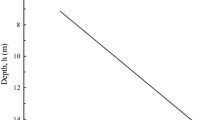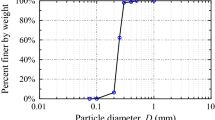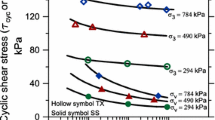Abstract
Under undrained cyclic loading, sand experiences decrease in effective stress, which can result in liquefaction. Test results show that large cyclic shear strain is generated at zero effective stress during undrained cyclic loading. This post-liquefaction shear strain has been observed to progressively increase in amplitude with increasing number of loading cycles until it eventually stabilizes at a bounded value. However, there has been no clear explanation on why and how this cyclic shear strain is generated. The fabric mechanism behind this post-liquefaction shear strain phenomenon is briefly discussed in this study.
You have full access to this open access chapter, Download conference paper PDF
Similar content being viewed by others
1 The Basic Phenomenon
Under undrained cyclic loading, a sand sample experiences decrease in effective stress p, which can be large enough so that p approaches zero where the phenomenon of liquefaction takes place. The undrained stress path follows what is commonly known as the butterfly path shown in Fig. 38.1. Along with the reduction of p, some test results show that large cyclic shear strain is generated at a low but nontrivial shear stress values (Fig. 38.1a), but more recent evidence suggests that it is in fact generated at low enough shear stress values to be seen as zero (Fig. 38.1b, c). Zhang and Wang (2012) referred to this shear strain as post-liquefaction shear strain γ0, considered to be generated at zero effective stress (i.e., liquefaction) state and has been observed to progressively increase in amplitude with increasing number of loading cycles until it eventually stabilizes at a bounded value. However, there has been no clear explanation on why, when and how this cyclic shear strain is generated. Without a clear understanding of this phenomenon, constitutive modelling would inevitably deviate from the actual behavior of the material, impeding the progress of validation of constitutive models by analyzing relevant BVP related to liquefaction as in the LEAP project.
2 Fabric Mechanism
Using DEM simulation, we were able to connect post-liquefaction shear deformation development to a new, theoretically measurable intrinsic fabric metric with a clear physical interpretation (Wang et al. 2016). This new fabric measurement, “Mean Neighboring Particle Distance” (MNPD), is the mean value over all particles of the “Neighboring Particle Distance” (NPD) as depicted in Fig. 38.2a, which is the mean surface-to-surface distance between a particle and its n closest neighbor particles, with n being the number of contacts needed to support a stable load-bearing structure (n = 3 in 2D and 4 in 3D). MNPD is formulated to capture a microstructural feature of granular materials that is closely related to deformation behavior in the post-liquefaction state by actually being a measure of “distance to establishing load-bearing contact” as opposed to a conventional measure of contact intensity, the coordination number. MNPD’s strong, unique correlation with γ0 is evident from Fig. 38.2b, c. It has also been shown to influence the liquefaction resistance of sand (Wang et al. 2019). Therefore, it is expected that consideration of MNPD can provide a promising path to incorporating the mechanism of the post-liquefaction cyclic shear strain phenomenon into a continuum constitutive framework for practical purposes.
The concept of MNPD (Mean Neighboring Particle Distance) and its correlation with post-liquefaction shear strain: (a) illustration of the surface-to-surface distance between a particle and its three closest neighboring particles; (b) development of γ0 and MNPDmax in a typical DEM test; (c) correlation between γ0 and MNPDmax in each half loading cycle after initial liquefaction in 17 tests
References
Arulmoli, K., Muraleetharan, K. K., Hossain, M. M., & Fruth, L. S. (1992). VELACS: Verification of liquefaction analysis by centrifuge studies, laboratory testing program, soil data report. The Earth Technology Corporation, Project No. 90-0562, Irvine, CA.
Chiaro, G., Kiyota, T., & Koseki, J. (2013). Strain localization characteristics of loose saturated Toyoura sand in undrained cyclic torsional shear tests with initial static shear. Soils and Foundations, 53(1), 23–34.
Wang, R., Fu, P., Zhang, J. M., & Dafalias, Y. (2016). DEM study of fabric features governing undrained post-liquefaction shear deformation of sand. Acta Geotechnica, 11(6), 1321–1337.
Wang, R., Fu, P., Zhang, J. M., Dafalias, Y. F. (2019). Fabric characteristics and processes influencing the liquefaction and re-liquefaction of sand. Soil Dynamics and Earthquake Engineering, 125, 105720.
Zhang, J. M., & Wang, G. (2012). Large post-liquefaction deformation of sand, part I: Physical mechanism, constitutive description and numerical algorithm. Acta Geotechnica, 7(2), 69–113.
Acknowledgement
Support from the European Research Council under FP7-ERC-IDEAS Advanced Grant Agreement n 290963 (SOMEF) is acknowledged.
Author information
Authors and Affiliations
Corresponding author
Editor information
Editors and Affiliations
Rights and permissions
Open Access This chapter is licensed under the terms of the Creative Commons Attribution 4.0 International License (http://creativecommons.org/licenses/by/4.0/), which permits use, sharing, adaptation, distribution and reproduction in any medium or format, as long as you give appropriate credit to the original author(s) and the source, provide a link to the Creative Commons license and indicate if changes were made.
The images or other third party material in this chapter are included in the chapter's Creative Commons license, unless indicated otherwise in a credit line to the material. If material is not included in the chapter's Creative Commons license and your intended use is not permitted by statutory regulation or exceeds the permitted use, you will need to obtain permission directly from the copyright holder.
Copyright information
© 2020 The Author(s)
About this paper
Cite this paper
Wang, R., Fu, P., Zhang, JM., Dafalias, Y.F. (2020). Post-liquefaction Cyclic Shear Strain: Phenomenon and Mechanism. In: Kutter, B., Manzari, M., Zeghal, M. (eds) Model Tests and Numerical Simulations of Liquefaction and Lateral Spreading. Springer, Cham. https://doi.org/10.1007/978-3-030-22818-7_38
Download citation
DOI: https://doi.org/10.1007/978-3-030-22818-7_38
Published:
Publisher Name: Springer, Cham
Print ISBN: 978-3-030-22817-0
Online ISBN: 978-3-030-22818-7
eBook Packages: EngineeringEngineering (R0)






